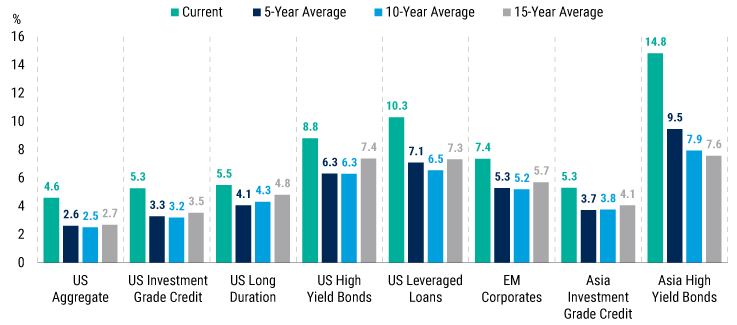2023 Midyear Fixed Income Outlook: Looking East

Steven Oh, CFA
Co-Head of Leveraged Finance
We are continuing to shift toward a more global portfolio approach after favoring US assets last year, and Asia credit looks especially compelling, with China’s ongoing (if uneven) reopening and pro-growth policy stance providing tailwinds.
Emerging market (EM) credit is set to benefit from faster economic growth, which could spur the widest growth premium between emerging and developed markets in a decade, and we see opportunities across select LatAm markets and beyond.
While our relative focus has shifted to Asia and EMs, where most portfolios are underweighted, developed market fixed income still serves a critical role in portfolios and may offer attractive risk-adjusted return potential relative to equities.

Much has changed since a year ago, when we favored shifting fixed income credit risk toward the US due to its relative economic strength and the dollar’s dominance, while maintaining a shorter duration with expectations of ongoing Fed tightening. Now in the second half of 2023, it’s essentially the reverse, with a continued shift toward a more global portfolio approach, including a renewed focus on emerging markets. With the US economy and currency weakening relative to other markets, we have favored adding to attractive risk-adjusted return opportunities beyond the US – with a particular focus on Asia.
While we maintain a marginally defensive credit selection bias amid ongoing volatility, and US fixed income continues to offer very attractive yields in portfolios, we see a strong case for a regional pivot into areas with relatively improving fundamentals. These include emerging markets in Asia and beyond, where growth prospects look more compelling than in the US and central banks will be supportive with an earlier shift toward easing policy.
Looking past this year, we believe credit, including that in the US, is positioned to deliver strong risk-adjusted returns – notably relative to equities.
Key Convictions
Credit overall has been remarkably resilient this year, though volatility is likely to persist amid lingering regional banking concerns in the US, ongoing elevated inflation, the uncertain path of interest rates, and tighter financing conditions. Yields look compelling, and we believe investors can take advantage of attractive opportunities across fixed income markets and regions in the second half of 2023 as well as capitalize on increasing dispersion among issuers.
Credit Yields Are at Decade-Long Highs and Exceed Long-Term Averages
Yield (%)

Source: Bloomberg as of 31 May 2023. US Aggregate represented by the Bloomberg US Aggregate Bond Index Yield to Worst (YTW). US Investment Grade Credit is the Bloomberg US Credit Index YTW. Asia Investment Grade Credit is the JP Morgan Asia Credit Index (JACI) Investment Grade YTW. US Long Duration Credit is the Bloomberg US Long Credit Index YTW. Emerging Market Corporates is the JPM CEMBI Broad Diversified YTW. US High Yield Bonds is the Bloomberg US Corporate High Yield Bond Index YTW. US Leveraged Loans is the Credit Suisse Leveraged Loan Index Yield (3-Year Life). Asia High Yield Bonds is the JACI High Yield YTW.
We have strong convictions in a few key areas:
1. Asia credit shines.
China’s ongoing (if uneven) reopening and pro-growth policy stance are tailwinds for Asian credit, and we’re broadly favorable on the region while maintaining a selective approach.
Asia credit offers areas of compelling alpha generation. On the back of the reopening and recovery in mainland China and beyond, we see select opportunities in consumer-driven areas such as Macau’s gaming sector, travel and leisure, and Hong Kong retailers. Elsewhere in the region, we see selective opportunities in India’s renewables sector and in certain commodities. The extent to which domestic companies in China can benefit from monetary policy easing, the shakeout of firms that survive the bailout of the property sector, and generally who benefits from the reopening of the economy will continue to shape credit opportunities in the critical China market.
A positive macro backdrop and less-hawkish monetary policy benefit Asian high yield issuers. We expect Asia’s GDP growth to accelerate year-over-year in 2023 (from 3.0% in 2022) as China’s growth rebounds to 5%, and many other Asian countries are also exhibiting favorable growth dynamics. This contrasts with recession concerns in the US and other developed economies. Monetary tightening in Asia has also been less severe than in developed markets, and China has been easing policies, putting less pressure on corporates from increasing funding costs than in other regions. Domestic funding access in major economies remains favorable, with funding costs even trending down for select high-quality corporates.
Asian HY issuers show stable or improving fundamentals and attractive valuations. The China property sector is about 15% of the Asia HY market,1 and while defaults among the weakest names will continue to emerge, select high-quality issuers will benefit from ongoing policy support and provide a good risk/reward at double-digit potential yields. Defaults for Asia ex China properties are expected to remain low at 0.7% in 2023, versus 2.3% for US high yield (note that Asia ex China’s property default rate averaged 1.7% for the past 12 years, versus 2.3% for US high yield over the same period).2 Compared to US HY, this space is providing a roughly 100-150 bp pickup for a one-notch higher rating, 1.5 years shorter duration, and a lower expected default rate.3
US dollar-denominated Asia investment grade (IG) bonds are an appealing diversifier. Tested by a number of shocks over the past few years, they have consistently offered compelling relative returns, especially when adjusted for risk. Steady credit metrics, a shorter duration profile, and attractive yields continue to attract both regional and global investors.
2. EM debt offers select opportunities in a diverse market.
Investors tend to be underexposed to emerging markets, and we see compelling risk-adjusted return potential for those who rotate into these assets.
EM is set to benefit from faster economic growth. While developed market economies face uncertainty about the ongoing tightening of monetary policy and its impact on economic activity and financial conditions (as evidenced by the collapse of several US regional banks and Credit Suisse), emerging markets are poised for a rise in economic growth. This could spur the widest growth premium between emerging and developed markets in a decade. In addition to Asia, we see opportunities across select LatAm markets and beyond.
China’s reopening has many global beneficiaries. The bulk of EM trade is with other emerging markets, and while many local Asian economies will be the primary beneficiaries of China’s growth, a number of economies and industrial sectors across the Middle East, Africa, and Latin America will also benefit from increased trade with China.
EM corporates have strong balance sheets. Against a backdrop of tighter financial conditions globally, EM corporates’ leverage ratios are at decade-low levels: the EM investment grade corporate net leverage ratio stands at 0.9x, versus 2.6x for US investment grade corporates, while the ratio for EM HY corporate net leverage is 1.8x, versus 3.4x for US HY corporates.4
Lower supply, higher demand. The conservative management of maturities and tighter environment for refinancing have seen primary supply of EM corporate debt fall to multi-year lows. Conversely, higher yields, a positive economic outlook, and strong credit fundamentals should all support an increase in demand from both dedicated EM and crossover investors.
Opportunities span ratings, geographies, and sectors. The inversion of credit curves has made front-end, highly rated EM corporates attractive, in our view. Broadly speaking, BBB rated corporates are looking good across the curve, particularly as many have standalone credit profiles that exceed their BBB ratings due to sovereign rating ceilings. We are looking at opportunities across Asia and like global commodity exporters – both areas that stand to benefit from a resurgence in China’s economy.
Emerging markets could add important diversification benefits. The recent banking turmoil in developed markets highlights the value of EM as a diversifier from a fundamental risk standpoint, and echoes similar dynamics seen during the global financial crisis.
3. Developed market credit may offer attractive risk-adjusted return potential relative to equities.
While our relative focus has shifted to Asia and EMs, where most portfolios are underweighted, developed market fixed income still serves a critical role in portfolios and offers several key benefits.
DM leveraged finance offers compelling risk-adjusted return potential. With their attractive average price discounts to par and favorable spreads relative to future defaults, which we expect to return toward historical averages, US leveraged finance asset classes now offer a risk-adjusted return proposition in relation to equities, and with potentially lower risk. In Europe, we view valuations as attractive but remain selective on issuers. While tail risks (including the specter of energy rationing) have faded, inflation remains sticky, particularly in the UK, and further rate hikes are expected. We see potential for a mild recession across developed markets, but the negative impact will be dampened by strong employment relative to prior economic downturns.
Floating-rate bank loans and collateralized loan obligations (CLOs) have had an edge over fixed-rate high yield bonds since the beginning of 2022, given that floating-rate assets provide protection against rising rates. We believe the value proposition between fixed and floating-rate assets remains in the short term, with materially higher total yields, but it has tilted closer toward neutral.
High yield bonds also offer a benefit that many investors may be overlooking: the discount in terms of the average price relative to par. Historically, during periods like today when the weighted average price for the high yield market offered a significant discount to par, we have seen attractive entry points to add to the asset class.
Investment grade CLO tranches offer a tradeoff between BB rated leveraged loans and high yield bonds, as well as yield pickup compared to similarly rated investment grade corporate debt. While Europe’s market is smaller and thinner relative to the US, we think segments of European CLO tranches look particularly attractive.
Investment grade credit proffers additional benefits. Investment grade credit is showing sufficient all-in yields relative to where they had been historically, making for a potentially opportune time to lock in yields, which will defuse liabilities for pension funds and insurers. Looking at fixed income versus equities, currently the yield-to-maturity on a five-year Treasury is roughly 200 basis points (bps) higher than the dividend yield on the S&P 500 Index, a wide differential relative to the 20-year average of 35 bps.5 Over the past two decades, when this differential has been considerably higher than longer-term averages, subsequent performance for fixed income asset classes has generally been better. This means investors may be able to de-risk their portfolios from beta equities into credit while still getting a compelling rate of return through return-generating income.
Turning East
If last year was about shifting credit risk toward the US to avoid areas where risks appeared greater, the second half of 2023 is about continuing the more global approach we pivoted to at the start of the year, and we believe the case for Asia is especially strong. All told, credit appears positioned to deliver strong risk-adjusted returns – notably relative to equities – but the bouts of volatility we’ve experienced are likely to continue. This backdrop argues for a flexible, nuanced approach to help ensure investors make the most of their fixed income exposures for the remainder of 2023 and beyond.
For more of our views on what investors and markets can expect in the second half, see our 2023 Midyear Investment Outlook.
Disclosure
Investing involves risk, including possible loss of principal. The information presented herein is for illustrative purposes only and should not be considered reflective of any particular security, strategy, or investment product. It represents a general assessment of the markets at a specific time and is not a guarantee of future performance results or market movement. This material does not constitute investment, financial, legal, tax, or other advice; investment research or a product of any research department; an offer to sell, or the solicitation of an offer to purchase any security or interest in a fund; or a recommendation for any investment product or strategy. PineBridge Investments is not soliciting or recommending any action based on information in this document. Any opinions, projections, or forward-looking statements expressed herein are solely those of the author, may differ from the views or opinions expressed by other areas of PineBridge Investments, and are only for general informational purposes as of the date indicated. Views may be based on third-party data that has not been independently verified. PineBridge Investments does not approve of or endorse any republication of this material. You are solely responsible for deciding whether any investment product or strategy is appropriate for you based upon your investment goals, financial situation and tolerance for risk.




